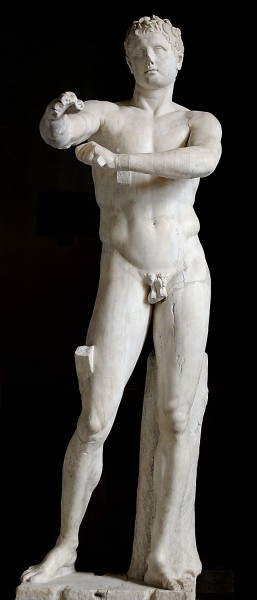 Roman copy of the Apoxyomenos by Lysippos, original c. 330 BCE, Museo Pio-Clementino, Vatican City, Rome, Photo by Marie-Lan Nguyen via Wikimedia Commons.
Roman copy of the Apoxyomenos by Lysippos, original c. 330 BCE, Museo Pio-Clementino, Vatican City, Rome, Photo by Marie-Lan Nguyen via Wikimedia Commons.
The Apoxyomenos, or the “Scraper,” is a popular subject in ancient Greek art that depicts athletes cleaning themselves by rubbing olive oil on their bodies and then scraping it off with a curved metal scraper, called a strigil.
This particular marble sculpture is a Roman copy of a famed bronze original by Lysippos, the court sculptor for Alexander the Great. Compared to earlier Greek sculptures of athletes, Lysippos’s interpretation is typically idealized and based on a rational, mathematical formula; yet, the head is relatively small and the limbs are elongated and graceful.
The Roman Emperor Tiberius was so enamored with Lysippos’s original bronze Apoxyomenos, that he moved it from the Baths of Agrippa in Rome to his bedroom, but had to return it after a public uproar.
 Roman copy of the Apoxyomenos by Lysippos, original c. 330 BCE, Museo Pio-Clementino, Vatican City, Rome, Photo by Marie-Lan Nguyen via Wikimedia Commons.
Roman copy of the Apoxyomenos by Lysippos, original c. 330 BCE, Museo Pio-Clementino, Vatican City, Rome, Photo by Marie-Lan Nguyen via Wikimedia Commons.
 Roman copy of the Apoxyomenos by Lysippos, original c. 330 BCE, Museo Pio-Clementino, Vatican City, Rome, Photo by Marie-Lan Nguyen via Wikimedia Commons.
Roman copy of the Apoxyomenos by Lysippos, original c. 330 BCE, Museo Pio-Clementino, Vatican City, Rome, Photo by Marie-Lan Nguyen via Wikimedia Commons.

